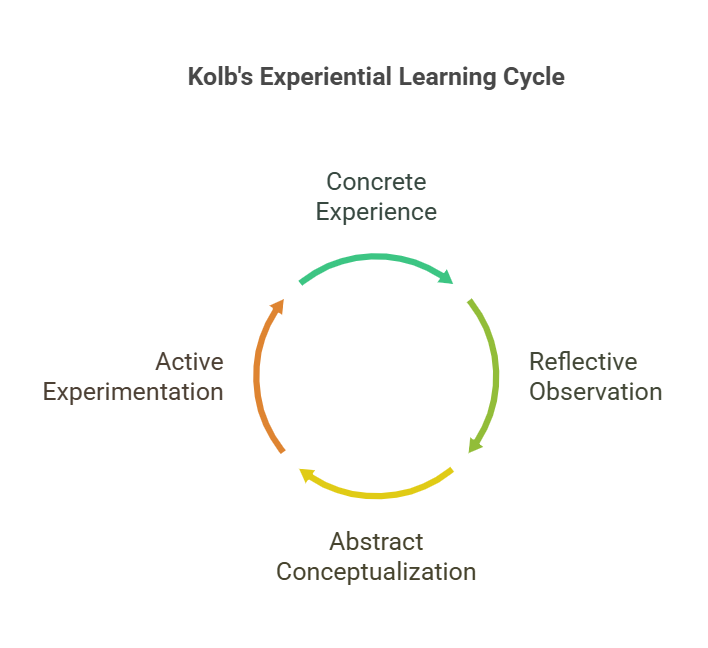Education and personal development have become pivotal in today’s knowledge-driven world. Among various theories and models that guide effective learning, the Kolb learning styles framework stands out for its simplicity and depth.
Developed by David Kolb in the 1980s, this model provides insights into how individuals learn and adapt, making it invaluable in both academic and professional contexts.
A report by the National Center for Education Statistics (NCES) indicates that students who learn through tailored teaching strategies—like those based on learning styles—perform up to 20% better in tests compared to those in one-size-fits-all settings.
Similarly, a study in workplace training found that organizations implementing learning style-based programs saw a 30% increase in employee retention and skill application. These statistics underscore the practical importance of learning models like Kolb’s.
In this article, we will explore Kolb learning styles in detail, highlighting its components, significance, and practical applications. We’ll also discuss Kolb’s experiential learning cycle, the Kolb model of learning, and key elements such as abstract conceptualization, active experimentation, and reflective observation to give you a well-rounded understanding of this influential theory.
The Foundations of Kolb Learning Styles
The Kolb learning styles model stems from experiential learning theory, which asserts that knowledge is gained through experience. This approach emphasizes the role of active engagement and reflective thought in the learning process.
Understanding the foundation of this model is essential for applying it effectively.
Kolb identified two primary dimensions of learning: how individuals perceive information and how they process it. These dimensions interplay to form a cycle of continuous learning and adaptation.
Let’s explore these foundational aspects.
Experiential Learning Theory
Experiential learning theory forms the backbone of Kolb’s framework. It posits that learning is a holistic process of adapting to the world. Unlike traditional rote memorization, experiential learning emphasizes the transformation of experiences into actionable knowledge.
This approach has gained widespread recognition for its relevance in modern education and professional training.
Key Dimensions of Learning
Kolb’s model identifies two critical dimensions:
- Perception: Learners process information through either concrete experiences (feeling) or abstract conceptualization (thinking).
- Processing: Learners engage with information by either reflective observation (watching) or active experimentation (doing). These dimensions combine to create a dynamic cycle of learning that allows individuals to adapt and grow.
Breaking Down Kolb’s Experiential Learning Cycle
Kolb’s experiential learning cycle is a cornerstone of his theory, outlining four stages that facilitate effective learning. Understanding this cycle helps learners and educators create meaningful and impactful experiences.

Concrete Experience (CE)
This stage involves direct participation in an activity or task. It’s the starting point where learners immerse themselves in a situation, gaining firsthand knowledge through involvement. Examples include participating in a group project or attending a workshop.
Reflective Observation (RO)
In this phase, learners step back to analyze their experiences. By observing and reflecting, they identify patterns, strengths, and areas for improvement. This critical thinking phase is essential for drawing meaningful insights from the experience.
Abstract Conceptualization (AC)
Here, learners synthesize their reflections into theories, models, or frameworks. This stage emphasizes analytical thinking and the ability to connect practical experiences with broader concepts.
Active Experimentation (AE)
The final stage involves applying the newly gained knowledge in real-world scenarios. Learners test their theories and refine their understanding through active practice, completing the cycle and paving the way for new experiences.
The Four Kolb Learning Styles
Kolb’s model categorizes learners into four distinct styles, each with unique characteristics and preferences. Understanding these styles enables tailored learning approaches that enhance engagement and retention.
Diverging: The Creative Thinker
Diverging learners are imaginative and excel in brainstorming and creative exploration. They prefer learning through observation and enjoy working collaboratively.
Characteristics of Diverging Learners
Diverging learners are often empathetic, open-minded, and inclined toward artistic pursuits. They thrive in environments that encourage discussion and free expression.
Effective Strategies for Diverging Learners
Activities like group discussions, role-playing, and visual storytelling can engage these learners effectively. Educators should focus on fostering a supportive and inclusive atmosphere.
Assimilating: The Analytical Planner
Assimilating learners prioritize logic and organization. They excel at understanding theoretical concepts and value structured, well-organized information.
Characteristics of Assimilating Learners
These learners are methodical, detail-oriented, and prefer a systematic approach to problem-solving. They often seek clarity and precision in their learning experiences.
Effective Strategies for Assimilating Learners
Providing charts, graphs, and structured lectures caters to their analytical nature. Case studies and models are also effective tools.
Converging: The Problem-Solver
Converging learners are practical and goal-oriented. They excel in technical tasks and enjoy experimenting with new ideas to solve problems.
Characteristics of Converging Learners
These learners are decisive, focused, and highly motivated by results. They prefer hands-on activities that allow them to test their skills and ideas.
Effective Strategies for Converging Learners
Simulations, technical projects, and real-world problem-solving tasks are ideal for engaging these learners. Encouraging innovation and experimentation can unlock their potential.
Accommodating: The Action-Oriented Learner
Accommodating learners thrive in dynamic, fast-paced environments. They prefer learning by doing and are highly adaptable to changing situations.
Characteristics of Accommodating Learners
These learners are intuitive, flexible, and often take risks. They excel in roles requiring quick decision-making and adaptability.
Effective Strategies for Accommodating Learners
Interactive workshops, internships, and fieldwork offer these learners the opportunity to apply their skills practically. Flexibility in learning environments is key.
Applying Kolb Learning Styles in Education
The Kolb model is highly applicable in educational settings, allowing educators to create personalized learning experiences. By understanding individual preferences, teachers can design curricula that maximize engagement and effectiveness.
Customizing Curriculum Design
Incorporating a mix of theoretical and practical activities ensures all learning styles are addressed. For example, group projects cater to diverging learners, while hands-on workshops engage accommodating learners.
Enhancing Classroom Dynamics
Understanding the diversity of learning styles fosters a collaborative and inclusive classroom environment. Students learn to appreciate different perspectives, enhancing teamwork and communication skills.
Kolb Learning Styles in Corporate Training
In the corporate world, Kolb’s model provides a framework for designing effective training programs. Tailored approaches enhance employee engagement and knowledge retention, driving organizational success.
Building Effective Training Modules
Incorporating elements of Kolb’s learning cycle ensures training programs cater to diverse employee needs. For instance, combining reflective observation with active experimentation creates a balanced learning experience.
Driving Professional Development
Understanding learning styles helps managers and trainers identify employees’ strengths and areas for improvement. This insight enables targeted professional development initiatives that yield tangible results.
Overcoming Criticisms of Kolb’s Model
Despite its popularity, the Kolb model has faced criticism for oversimplifying the complexities of learning. Critics argue that fixed styles may not account for the fluid nature of individual preferences.
Addressing Flexibility
Recognizing that learning styles can vary based on context ensures a more adaptable approach. Encouraging learners to explore multiple styles enhances their versatility and resilience.
Emphasizing Continuous Learning
Rather than viewing styles as rigid categories, educators and trainers can emphasize the continuous nature of Kolb’s cycle. This perspective highlights growth and adaptability as key learning outcomes.
Conclusion: Unlock Your Learning Potential
The Kolb learning styles and the Kolb’s experiential learning cycle offer a transformative framework for understanding and enhancing learning experiences.
By incorporating elements like abstract conceptualization, active experimentation, and reflective observation, individuals and organizations can unlock new levels of growth and productivity.Whether you’re a student, educator, or professional, applying Kolb’s principles can lead to more effective and fulfilling learning journeys. Start exploring your learning style today and discover how it can shape your path to success.

